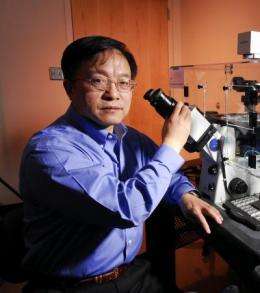Researchers identify gene that may play key role in atherosclerosis, other diseases

To understand the role of inflammation in cardiovascular and other diseases, it is essential to identify and characterize genes that induce an inflammatory response in the body -- and the genes that regulate them.
A study published online this week in the journal Proceedings of the National Academy of Sciences suggests that a gene called Hu antigen R (HuR) plays a critical role in inducing and mediating an inflammatory response in cells experiencing mechanical and chemical stresses. The study was supported by the National Institutes of Health.
The findings may open up new possibilities for developing treatments of metabolic diseases associated with inflammation, such as atherosclerosis. Atherosclerosis typically occurs in branched or curved regions of arteries where plaques form because of cholesterol build-up. Inflammation can alter the structure of plaques so that they become more likely to rupture, causing a blood vessel blockage and leading to heart attack or stroke.
"This is the first systematic study showing that HuR not only responds to external stimuli as a stress-sensitive gene, but it also regulates other stress-sensitive genes," said senior author Gang Bao, the Robert A. Milton Chair in Biomedical Engineering in the Wallace H. Coulter Department of Biomedical Engineering at Georgia Tech and Emory University.
The study results show that HuR promotes the expression of genes that support atherosclerosis and inhibits the expression of genes that combat atherosclerosis.
"We found that suppressing expression of HuR inhibited the inflammatory response of cells, which shows that designing drugs that block HuR function may reduce the risk of plaques rupturing," explained Bao.
Bao guided Won Jong Rhee, a former postdoctoral fellow in his laboratory, to conduct a series of experiments investigating the biology, behavior and pathways of HuR.
The researchers first studied how the HuR gene responds to different flow environments and chemical treatments. They exposed human umbilical vein endothelial cells to disturbed flow -- which occurs in artery regions where plaques form -- and found that the cells expressed higher levels of HuR than when they experienced a static or laminar flow environment. This finding was validated in tissue experiments with results showing increased amounts of HuR in regions of a mouse aorta that were exposed to disturbed flow.

Then the researchers treated endothelial cells with statins, medications used to treat atherosclerosis by reducing the number of cholesterol-containing low-density lipoprotein (LDL) molecules in the blood and inhibiting inflammation. The results indicated a decreased level of HuR with statin treatment.
After establishing HuR as a stress-sensitive gene regulated by external stimuli, including flow and statin treatment, the researchers conducted experiments to determine whether HuR regulates the expression of other stress-sensitive genes. They found that reducing the level of HuR in cells increased the levels of two genes that combat atherosclerosis -- Kruppel-like factor 2 (Klf2) and endothelial nitric oxide synthase (eNOS). The reduction in HuR also decreased the expression of bone morphogenic protein-4 (BMP-4), a gene that supports atherosclerosis.
Reducing the level of HuR in cells also significantly inhibited many inflammatory responses of the endothelial cells, including the expression of two potential atherosclerosis drug targets: inter-cellular adhesion molecule-1 (ICAM-1) and vascular cell adhesion molecule-1 (VCAM-1).
Though this study showed that HuR plays a critical role in inducing and mediating an inflammatory response in cells subjected to a stressful environment, the underlying mechanism for this regulation is still not known.
"HuR protein often binds to messenger RNAs to increase their stability and translation, but we found that regulation of other stress-sensitive genes by HuR was not due to changes in mRNA stability by direct protein binding," explained Bao.
To uncover the pathways that lead to HuR's stress sensitivity, the researchers conducted a series of studies to reveal that HuR functions by adding a phosphate group to the transcriptional factor nuclear factor kappa B (NFkB) and its inhibitor IkBa. Additional research is underway to reveal what mRNAs HuR binds to and the mechanisms used to respond to mechanical and chemical stresses. Identifying the triggers for inflammation and unraveling the details of inflammatory pathways may eventually furnish new therapeutic targets.















